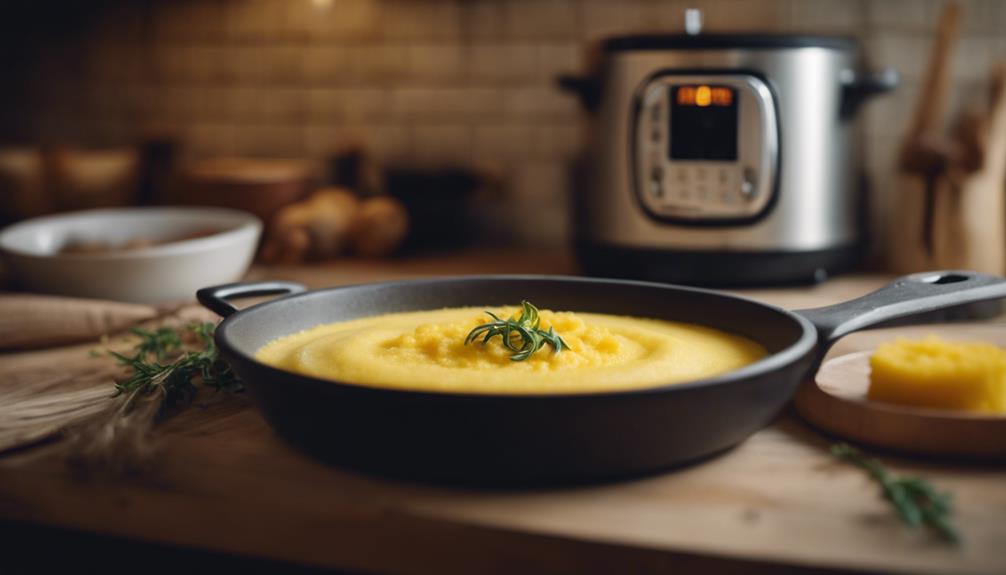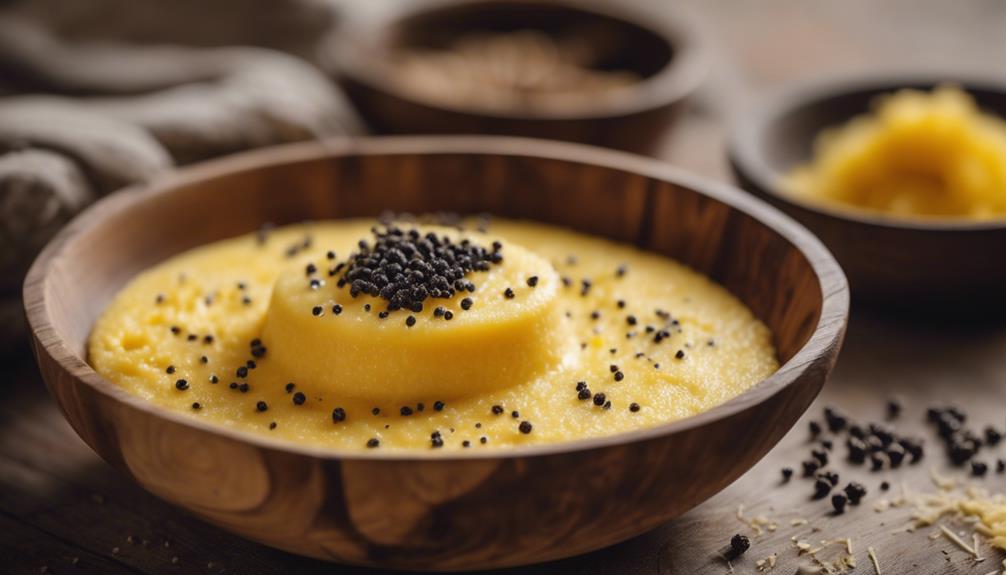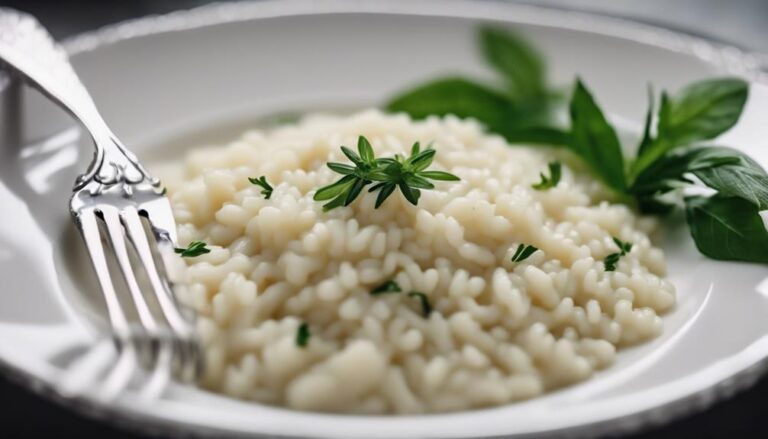Sous Vide Creamy Polenta
For a lusciously smooth and consistently creamy polenta, try sous vide cooking. It gives you precise temperature control, ensuring perfect results every time. Sous vide method keeps your polenta velvety without the need for constant stirring. Set the temperature, seal the ingredients in a bag, then immerse in a water bath. The slow, gentle heat creates a heavenly texture. Experiment with different creaminess levels and flavor infusions to suit your palate. Discover how sous vide technique elevates your polenta game effortlessly. Uncover expert tips on enhancing your creamy polenta with innovative methods and high-quality ingredients.
What You Will Learn Here
- Sous vide method ensures precise temperature control for consistently creamy polenta.
- Vacuum-sealed bags prevent water from diluting polenta's creaminess during cooking.
- Longer cooking times in sous vide enhance cornmeal's creaminess and flavor absorption.
- Minimal stirring required in sous vide cooking maintains polenta's smooth texture.
- Sous vide allows for convenient preparation of creamy polenta with minimal hands-on effort.
Polenta's Italian Origins

Italian Polenta has a rich history that dates back centuries, with a traditional recipe that remains a staple in Italian cuisine.
Understanding the origins of polenta can provide insight into its cultural significance and versatility as a dish.
Exploring its role in Italian culinary traditions can deepen your appreciation for this beloved comfort food.
Italian Polenta History
With its humble beginnings as a staple in the diets of Italian peasants, polenta has a rich culinary history that dates back centuries. Polenta, a dish made from coarsely ground cornmeal, originated in Northern Italy, particularly in regions like Lombardy and Veneto. It was a simple yet nourishing food that provided sustenance to many Italian families, especially during times of scarcity.
Historically, polenta was cooked slowly over a fire, demanding constant stirring to prevent lumps and guarantee a smooth texture. The dish was versatile, served soft and creamy or left to cool and solidify to be sliced and grilled or fried. In the past, polenta was often eaten with whatever ingredients were available, such as cheese, butter, or leftover meats.
Over time, polenta evolved from a peasant's meal to a beloved Italian staple enjoyed by people of all social classes. Today, polenta is celebrated not only in Italy but also internationally, appreciated for its comforting taste and versatility in various culinary preparations. The history of polenta reflects the resilience and resourcefulness of Italian cuisine, showcasing how a simple dish can transcend its humble origins to become a gourmet delight.
Traditional Polenta Recipe
After exploring the historical roots of polenta in Italian peasant cuisine, let's now uncover a traditional recipe that embodies the essence of this hearty dish.
To make a classic polenta, you'll need simple ingredients: cornmeal, water, salt, and perhaps a touch of butter or cheese for added richness. Begin by bringing water to a boil in a large pot. Add a generous pinch of salt to enhance the flavor. Slowly pour in the cornmeal, whisking constantly to prevent lumps from forming. Reduce the heat to low and let the mixture simmer, stirring occasionally to prevent sticking.
As the polenta cooks, it will gradually thicken and take on a creamy consistency. This process requires patience but rewards you with a comforting and satisfying dish. The traditional method involves simmering the polenta for an extended period, allowing the cornmeal to soften and develop its full flavor.
Once the polenta reaches a smooth and creamy texture, you can serve it hot as a side dish or as a base for various toppings such as ragu, mushrooms, or cheese. This traditional recipe captures the essence of Italian peasant cuisine, showcasing the humble yet versatile nature of polenta.
Polenta in Italian Cuisine
Amidst the rich tapestry of Italian culinary heritage, polenta stands out as a staple that traces its origins to humble beginnings in the northern regions of the country. Polenta, a dish made from boiled cornmeal, has been a fundamental part of Italian cuisine for centuries. In the northern regions of Italy, where the climate and terrain were more suitable for growing corn than wheat, polenta quickly became a dietary staple for the working class.
Originally, polenta was considered peasant food due to its simple ingredients and easy preparation. Corn, introduced to Europe from the New World in the 16th century, revolutionized Italian cuisine and led to the widespread adoption of polenta as a nutritious and versatile meal. Over time, polenta evolved from a basic porridge-like dish to a culinary delight enjoyed by people of all social classes.
Today, polenta remains a beloved Italian dish, appreciated for its comforting texture and ability to complement a wide range of flavors. Whether served creamy, grilled, or fried, polenta continues to hold a special place in the hearts and stomachs of Italians and food enthusiasts worldwide.
Polenta's Versatile Cornmeal Variations
Explore the diverse ways to elevate polenta by experimenting with different cornmeal variations. Polenta, a staple in Italian cuisine, can be customized using various types of cornmeal to achieve unique flavors and textures. Here are four common cornmeal variations you might want to explore:
- Yellow Cornmeal: This traditional option provides a classic golden hue and a slightly sweet flavor to your polenta. Yellow cornmeal is widely available and works well for both creamy polenta and firmer polenta dishes.
- Blue Cornmeal: For a striking visual presentation and a nuttier taste, blue cornmeal is an excellent choice. It adds a vibrant blue tint to your polenta and can be a fun twist on the traditional dish.
- Stone-Ground Cornmeal: Opting for stone-ground cornmeal gives your polenta a coarser texture and a more rustic flavor. The resulting polenta will have a hearty mouthfeel and a robust corn taste.
- Polenta Flour: Finely ground polenta flour creates a smooth and creamy polenta without the need for prolonged cooking. It's a convenient option for quick polenta dishes while still delivering a rich corn flavor.
Experimenting with these cornmeal variations can help you discover new dimensions of taste and texture in your polenta dishes. Each type offers a unique take on this classic comfort food, allowing you to tailor your polenta to suit your preferences and culinary creativity.
Creamy Polenta Recipes

Creamy Polenta Recipes offer a range of delicious options to elevate your dining experience. Velvety Mushroom Polenta, Truffle-Infused Polenta Recipe, and Rosemary Parmesan Polenta are just a few standout choices.
These recipes provide a perfect balance of flavors and textures that will impress your family and friends at any meal.
Velvety Mushroom Polenta
Indulge your taste buds with the luxurious combination of velvety mushrooms and creamy polenta in this delectable recipe. This velvety mushroom polenta is a comforting dish that will elevate any meal. Here are some reasons why you should try this delectable recipe:
- Rich Flavor: The earthy and umami-rich mushrooms complement the creamy polenta perfectly, creating a harmonious blend of flavors.
- Texture Contrast: The velvety mushrooms add a delightful contrast to the smooth and creamy polenta, making each bite a textural delight.
- Nutrient Boost: Mushrooms are packed with essential nutrients like vitamins, minerals, and antioxidants, adding a healthy element to this indulgent dish.
- Versatility: This velvety mushroom polenta can be served as a side dish to complement a variety of mains or enjoyed on its own for a satisfying vegetarian meal option.
Try this velvety mushroom polenta recipe to experience a symphony of flavors and textures that will leave you craving more.
Truffle-Infused Polenta Recipe
For a luxurious twist on classic polenta, infuse it with the decadent flavor of truffles in this tantalizing recipe. Truffle-infused polenta elevates the dish to a whole new level of sophistication, perfect for impressing guests or treating yourself to a gourmet experience.
Here's how to create this exquisite dish:
- Ingredients:
- Polenta
- Truffle oil
- Parmesan cheese
- Salt and pepper
- Preparation:
- Cook the polenta according to the package instructions.
- Once the polenta is cooked, stir in a generous amount of truffle oil for that rich, earthy flavor.
- Add grated Parmesan cheese to enhance the creaminess and depth of the dish.
- Season with salt and pepper to taste.
- Serving:
- Serve the truffle-infused polenta hot, allowing the flavors to shine through.
- Consider topping it with additional truffle shavings for a visually stunning presentation.
- Enjoy:
- Indulge in the luxurious taste of truffle-infused polenta, savoring each decadent bite.
Rosemary Parmesan Polenta
Enhance your polenta experience by infusing it with the aromatic flavors of rosemary and the rich creaminess of Parmesan cheese in this delectable recipe. Here's how to make Rosemary Parmesan Polenta that will elevate your meal:
- Gather Your Ingredients:
- 1 cup of cornmeal
- 4 cups of water or broth
- 2 tablespoons of butter
- Salt and pepper to taste
- Infuse with Rosemary:
- Add a few sprigs of fresh rosemary to the water or broth while heating it up to infuse the flavors.
- Cook the Polenta:
- Gradually whisk in the cornmeal to the simmering liquid, stirring constantly to avoid lumps.
- Let it cook, stirring occasionally, until it reaches a creamy consistency.
- Add Parmesan and Seasoning:
- Stir in the butter, grated Parmesan cheese, salt, and pepper until the cheese melts and the polenta is smooth.
Enjoy the creamy texture and the herby-cheesy goodness of Rosemary Parmesan Polenta with your favorite main dish.
Polenta Texture Enhancements
To enhance the texture of your polenta, consider exploring creamier variations that offer a smoother mouthfeel.
Experiment with flavor infusion techniques to add depth and complexity to your dish, elevating the overall taste experience.
Also, take into account the impact of serving temperature on the texture of your polenta, as warmer temperatures can affect its creaminess.
Creamier Polenta Variations
Consider incorporating different ingredients or techniques to achieve a creamier texture in your polenta. One way to enhance the creaminess of your polenta is by using a combination of milk and water instead of solely water when cooking it.
The milk adds richness and creaminess to the dish, resulting in a smoother texture. Another method is to swap some of the liquid with chicken or vegetable broth for added depth of flavor and silkiness.
Additionally, incorporating butter or cream towards the end of the cooking process can elevate the creaminess of your polenta to a whole new level. Stirring in grated cheese like Parmesan or Pecorino Romano can also contribute to a velvety consistency while imparting a delicious cheesy flavor.
Lastly, allowing the polenta to simmer longer on low heat, occasionally stirring to prevent sticking, can help break down the cornmeal further and create a luxuriously creamy texture. Experimenting with these variations can lead to a decadent and satisfying polenta experience.
Flavor Infusion Techniques
For a depth of flavor and enhanced creaminess in your polenta, infuse it with aromatic herbs and spices during the cooking process. Adding herbs like rosemary, thyme, or bay leaves to the cooking liquid can impart a subtle yet delightful flavor to your polenta. Spices such as black pepper, garlic powder, or smoked paprika can also elevate the taste profile of your dish.
To infuse the flavors effectively, tie the herbs in a cheesecloth or use a tea infuser ball before adding them to the cooking liquid. This method allows the herbs to release their flavors gradually without leaving any unwanted pieces in your polenta.
Experiment with different combinations of herbs and spices to find your preferred flavor profile. Remember to taste and adjust the seasonings as needed throughout the cooking process. By infusing your polenta with aromatic herbs and spices, you can create a dish that isn't only creamy but also bursting with rich and complex flavors.
Serving Temperature Impact
Maintaining the ideal serving temperature for your polenta is crucial for enhancing its texture and overall enjoyment. When served hot, polenta retains its creamy consistency, making each bite a delightful experience.
A warm temperature helps to keep the polenta soft and smooth, allowing it to spread easily on the plate and meld with accompanying flavors. If polenta is served too cold, it can become stiff and lose its luscious creaminess, detracting from the dish's appeal.
Similarly, serving polenta at too high a temperature can cause it to dry out quickly, affecting its texture and taste. To make sure your polenta is at its best, aim for a serving temperature that's comfortably warm to the touch but not scalding.
This way, you can enjoy the full potential of its velvety texture and rich flavor, creating a satisfying culinary experience with every spoonful.
Final Thoughts

If you're looking to enhance your culinary skills and impress your guests, experimenting with different ingredients and techniques can truly elevate your dishes. When it comes to making creamy polenta using the sous vide method, the attention to detail in each step is what sets your dish apart. From selecting the right ingredients to mastering the cooking process, every decision you make influences the final outcome.
One key aspect to keep in mind is the importance of using high-quality ingredients. Opting for finely ground cornmeal and flavorful stock can greatly impact the taste and texture of your polenta. Additionally, don't underestimate the power of seasoning. Adding a pinch of salt or a knob of butter at the right moment can bring out the rich flavors of the dish.
Furthermore, the sous vide technique allows for precise control over the cooking temperature, resulting in a consistently creamy texture. By following the recommended cooking times and temperatures, you can achieve a luxurious polenta that's smooth and velvety.
Frequently Asked Questions
Can Polenta Be Made Ahead of Time and Reheated?
Yes, you can make polenta ahead of time and reheat it. Simply store it in the fridge or freeze it for longer storage. When ready to enjoy, reheat it on the stove with a bit of liquid.
How Can I Make Vegan-Friendly Creamy Polenta?
To make vegan-friendly creamy polenta, use vegetable broth instead of dairy. Bring it to a simmer, whisk in cornmeal until thickened, and season with salt and pepper. Top with vegan butter or nutritional yeast for extra flavor.
Can I Use Instant Polenta for This Recipe?
Yes, you can use instant polenta for this recipe. It's convenient and quick to prepare, making it a suitable option. The key is to follow the instructions carefully to achieve the desired creamy texture in your dish.
What Are Some Creative Toppings for Creamy Polenta?
For creamy polenta, try topping it with sautéed mushrooms and Parmesan, or crispy prosciutto and a drizzle of balsamic glaze. Fresh herbs like basil or rosemary can add a burst of flavor. Enjoy experimenting!
Can I Use a Slow Cooker Instead of a Sous Vide for Polenta?
You can use a slow cooker instead of sous vide for polenta. Slow cookers offer a convenient way to make creamy polenta with minimal effort. Just adjust cooking times and liquid ratios accordingly to achieve a similar result.
Conclusion
To sum up, sous vide creamy polenta is a delicious and versatile dish that can be enjoyed in a variety of ways. Whether you prefer it as a side dish or as the main attraction, the creamy texture and rich flavor of polenta are sure to impress your taste buds.
With a little experimentation and creativity, you can customize your polenta to suit your preferences and create a dish that's truly unique and satisfying. Give it a try and elevate your culinary skills with this classic Italian dish.











